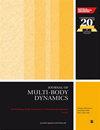基于滑模控制的含扭振工具钻柱粘滑抑制及参数不确定性鲁棒性研究
IF 1.9
4区 工程技术
Q3 ENGINEERING, MECHANICAL
Proceedings of the Institution of Mechanical Engineers Part K-Journal of Multi-Body Dynamics
Pub Date : 2021-10-16
DOI:10.1177/14644193211045273
引用次数: 3
摘要
钻柱粘滑振动过大,会造成钻井作业效率低下和不安全。为了抑制井下钻井过程中发生的粘滑振动,在4自由度集总参数模型的基础上,提出了考虑扭转振动工具的钻柱扭转振动系统。在模型的设计中,工具是用一个简单的扭摆来近似的,它给钻头带来冲击扭矩。此外,两个滑模控制器U1和U2用于抑制粘滑振动,同时使钻头能够跟踪所需的角速度。针对钻井作业中参数的不确定性和系统的不稳定性,在滑模控制器U2中加入了参数自适应律。最后,通过仿真和现场试验,比较了两种控制器的粘滑抑制效果和参数不确定性的鲁棒性。本文为抑制粘滑振动和进一步研究钻柱复杂动力学提供了参考。本文章由计算机程序翻译,如有差异,请以英文原文为准。
Study of stick–slip suppression and robustness to parametric uncertainty in drill strings containing torsional vibration tool using sliding-mode control
Excessive stick–slip vibration of drill strings can cause inefficiency and unsafety of drilling operations. To suppress the stick–slip vibration that occurred during the downhole drilling process, a drill string torsional vibration system considering the torsional vibration tool has been proposed on the basis of the 4-degree of freedom lumped-parameter model. In the design of the model, the tool is approximated by a simple torsional pendulum that brings impact torque to the drill bit. Furthermore, two sliding mode controllers, U1 and U2, are used to suppress stick–slip vibrations while enabling the drill bit to track the desired angular velocity. Aiming at parameter uncertainty and system instability in the drilling operations, a parameter adaptation law is added to the sliding mode controller U2. Finally, the suppression effects of stick–slip and robustness of parametric uncertainty about the two proposed controllers are demonstrated and compared by simulation and field test results. This paper provides a reference for the suppression of stick–slip vibration and the further study of the complex dynamics of the drill string.
求助全文
通过发布文献求助,成功后即可免费获取论文全文。
去求助
来源期刊

CiteScore
4.10
自引率
11.10%
发文量
38
审稿时长
>12 weeks
期刊介绍:
The Journal of Multi-body Dynamics is a multi-disciplinary forum covering all aspects of mechanical design and dynamic analysis of multi-body systems. It is essential reading for academic and industrial research and development departments active in the mechanical design, monitoring and dynamic analysis of multi-body systems.
 求助内容:
求助内容: 应助结果提醒方式:
应助结果提醒方式:


